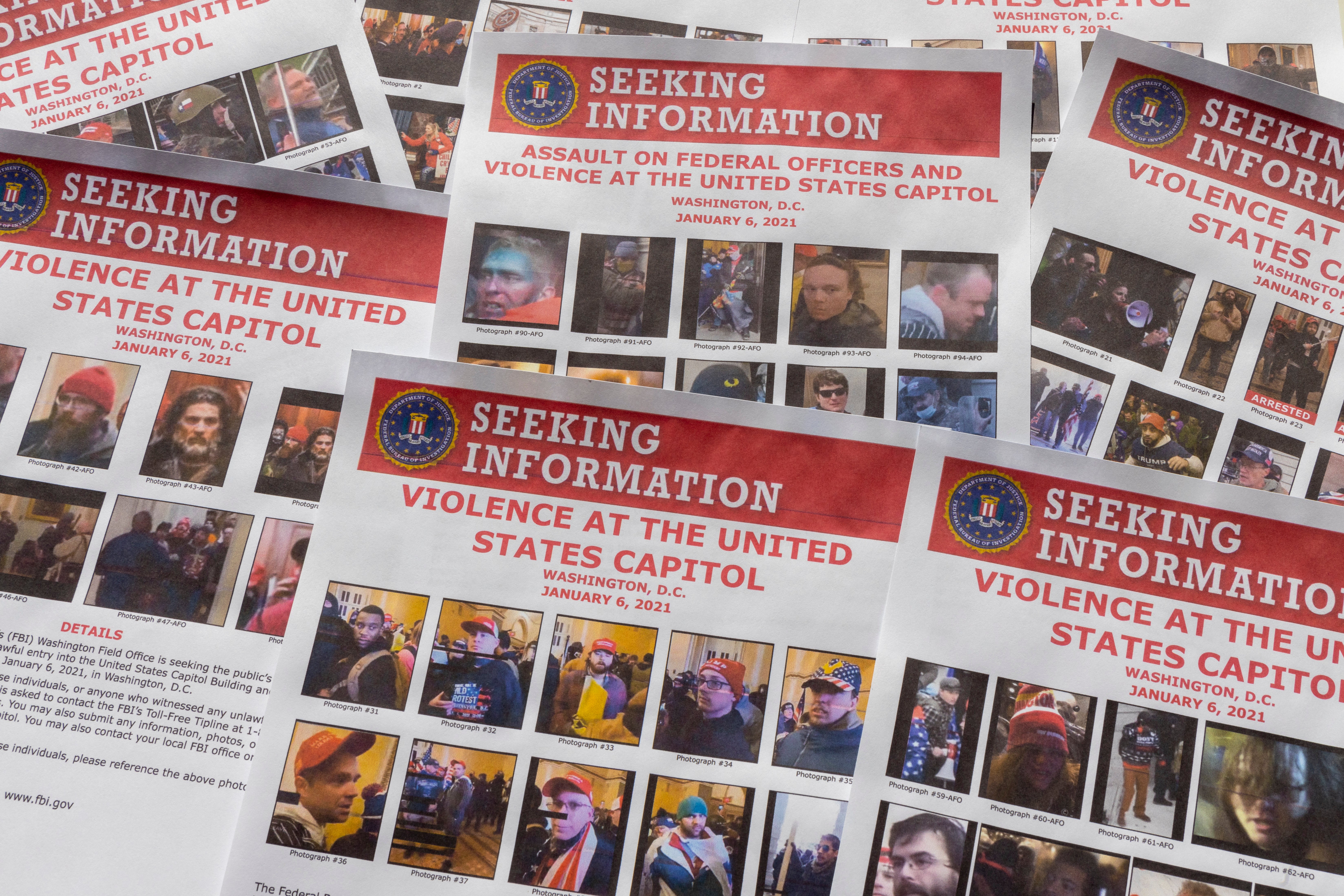One year on, what do we know about the people who stormed the Capitol?
More than 700 people have been charged for their role in the Capitol attack, Richard Hall asks experts what we know about those people

Your support helps us to tell the story
From reproductive rights to climate change to Big Tech, The Independent is on the ground when the story is developing. Whether it's investigating the financials of Elon Musk's pro-Trump PAC or producing our latest documentary, 'The A Word', which shines a light on the American women fighting for reproductive rights, we know how important it is to parse out the facts from the messaging.
At such a critical moment in US history, we need reporters on the ground. Your donation allows us to keep sending journalists to speak to both sides of the story.
The Independent is trusted by Americans across the entire political spectrum. And unlike many other quality news outlets, we choose not to lock Americans out of our reporting and analysis with paywalls. We believe quality journalism should be available to everyone, paid for by those who can afford it.
Your support makes all the difference.In the year since a large crowd of Donald Trump supporters stormed the US Capitol in an attempt to stop the certification of Joe Biden’s presidential victory, more than 700 people have been charged with federal crimes. The headlines about those cases have been dominated by a bold, loud few.
The so-called QAnon Shaman, Jacob Chansley, who led the mob through the marbled hallways wearing horns and a fur pelt, was sentenced to 41 months. Jenna Ryan, a Texas realtor who flew to Washington DC on a private jet before joining the rioters inside the building, only later to boast that she wouldn’t go to jail because she had “blonde hair” and “white skin”, was sentenced to 60 days. More complex cases are ongoing against members of far-right groups like the Proud Boys and the Oath Keepers militia.
But all of those cases may be obscuring an alarming fact about those who stormed the Capitol that day to halt the process of democracy, according to extremism researchers.
“The interesting thing about these people is that they are not interesting. You’ve got construction workers and yoga instructors. They come from a cross-section of America,” says Seamus Hughes, deputy director of the George Washington University’s (GWU) Program on Extremism.
“The Oath Keepers and the Proud Boys get a lot of media coverage, understandably so, but the vast majority of them are quite typical,” he says.
Hughes is part of a team of researchers that is tracking and researching every federal case related to the 6 January 2021 attack. Their database gives an insight into that cross-section of America.
They have found that of the 704 cases currently underway, the average age of those charged is 39-years-old — 613 of whom are men. They came from 45 states — including 75 from Florida, and 63 each from Texas and Pennsylvania. Eighty-one people who have been charged so far had prior military experience, around 12 per cent of the total.
For those who track and study extremism in the United States, that such a broad range of people chose to engage in the riot in some way is concerning.
“That’s almost more alarming, because it’s not alarming,” says Hughes. “There’s not a profile. They range from 18-81 in age. They come from 45 different states – they are all over the map. The unifying idea is that ‘we have to stop the steal’ [of the 2020 election]. But it’s kind of a hodge-podge of extremist beliefs.”
“It’s a reflection of where we are in domestic extremism in general,” he adds.
The investigation into the 6 January attack on the Capitol is the largest federal law enforcement probe in history. The Federal Bureau of Investigation’s (FBI) agents from more than 50 field offices across the country are scouring through nearly 250,000 internet tips, millions of social media posts, video and images to identify and arrest the perpetrators.
According to GWU’s database, more than 80 per cent of defendants were charged using evidence from their own social media accounts.

Tim Levon Boughner, 41, of Macomb County in Michigan, was typical of those charges. Federal investigators released photographs of him involved in violence at the Capitol, highlighting a star-shaped tattoo near his right wrist. Video showed him using chemical spray against a Capitol police officer. Prosecutors said Boughner bragged about his actions that day in a Facebook post in which he claimed he had “started spraying to “f*** those cops up.”
Robert Chapman, from Carmel, New York, was arrested after boasting of his Capitol antics to a match on the dating app Bumble. “I did storm the Capitol... I made it all the way to Statuary Hall,” Chapman wrote in the messages one week after the attack. The response from his potential partner: “We are not a match.”
Hundreds more were caught through their incriminating social media posts. During the riot, The Independent witnessed dozens of people – sometimes families together – of themselves inside and outside the Capitol, with violence raging just feet away from them. What that shows, according to Hughes, is that most of those in the crowd didn’t believe they were doing anything wrong.
“If 80 per cent of them are documenting their crimes on social media, it’s not because they are bad criminals, it’s because they believe they are patriots,” he says.
One thing that does stand out in the profiles of those charged is the high number of defendants with military training – around 12 per cent of the 704 charged so far, including five active service members and at least 55 veterans.
For Dr Gina Ligon, director of the National Counterterrorism Innovation, Technology, and Education Centre (NCITE) at the University of Nebraska at Omaha, that raises alarm bells.
“It is surprising when you compare it to the number of military-trained individuals in the general population who are of the same age demographics as those arrested. It is also alarming given that those charged with protecting our country saw an attack on it that day in line with their values. It shows that foreign-influenced messaging and corrupt leaders of extremist groups here were able to turn our own trained weapons against us,” she says.
Dr Ligon, who is from a military family herself, leads a research centre that studies extremist threats to the US, including domestic extremism. She believes military veterans were “specifically targeted to join up” in the Capitol attack – most of them after more than five years out of the service.
“This is when they were vulnerable – no longer had the identity associated with being part of a large powerful group (military), had their grievances manipulated to point their anger towards authority figures in symbols of our own government,” she says.
The Pentagon recently announced that it was updating its personnel policies to address a rise of extremism in the military, directly as a response to the high number of military and ex-military in the crowd on 6 January. The new guidelines include rules on social media use, for which “liking” or reposting extremist content would be viewed as advocating for that cause.

There is still a gap, however, according to Dr Ligon, with the veteran population.
“Continuous support for them in terms of training on what kinds of tactics these groups use to recruit them, what types of online information to trust, and how aberrant these group’s values are compared to those they had in the service is needed for years after separation – not just in the final weeks when they leave the military,” she says.
Like Hughes, Dr Ligon also notes with concern the large number of ordinary people who decided to do an extraordinary thing on 6 January.
“What’s happening in America right now, we always talk about the general population is like the water that allows extremists to swim faster to their target. And if they agree with you, the current is moving with you, even if they wouldn’t endorse the violence.”
On 6 January, she adds, the large crowds gave the more extreme actors in the crowd “tacit permission” to act.
“They themselves may not ever engage in violence, but by saying ‘I like what you’re doing,’ that gives them this psychological permission to just behave in horrible ways. I have just never seen it so openly in the US.”
The future of the 6 January prosecutions may be different than what came before, however. Hughes says the Department of Justice (DOJ) is “clearing the decks” by reaching plea deals for the minor and misdemeanour crimes so that they can devote resources to the more complex cases involving organised groups, for example.
Hughes says that it remains to be seen whether 6 January will be repeated.
“January 6 was a perfect storm. You had mainstream politicians encouraging conspiracy theories. You had a social media echo chamber that hadn’t figured out how to police itself on domestic extremism yet. And FBI and law enforcement that were behind the curve on what they were seeing,” he says.
“If you look at [subsequent rallies] on 20 January, or Justice for 6 January, you didn’t get the same crowds anymore. The soccer dad from Missouri, they know what they are getting into now, and wouldn’t go to a rally like that.”




Join our commenting forum
Join thought-provoking conversations, follow other Independent readers and see their replies
Comments